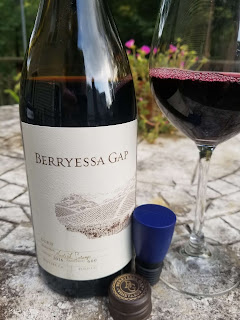The name Petite Sirah may have resulted from the grape's "petite" berries which provide plenty of intense fruit and high tannins. High acidity is another inherent characteristic of the grape - which with the tannins encourages aging. Other common notable characteristics are blackberry, chocolate, and black pepper flavors.
Berryessa Gap Vineyards is located in the Winters AVA and situated in the western corner of Yolo County, located off Route 128 between the town of Winters and the Vaca Mountains. Napa County lies on the western side of the ridge. The Berryessa estate - Coble Ranch vineyard - is planted along the eastern ridge of the Vaca Mountains and benefits from a climate that resembles the hot and dry conditions of Mediterranean climates.
Durif (Petite Sirah) is one of their many grapevines and the winery releases two versions. Their Berryessa Gap Petite Sirah ($27) is composed of 85% Durif, 10% Primitivo/Zinfandel, and 5% Peloursin and is modeled after the Rhone field blends copied admirably by California's Ridge Vineyards in Sonoma's Lytton Springs. The Durif in this wine is whole-berry fermented which tones down the tannins and intensity leading to a soft and elegant wine.
On the other hand, the Berryessa Gap Durif ($32) is 100% Durif, grown in its own plot elsewhere on the estate. For a sensory descriptor, the wine is juicy, with dense blueberries, slight spice, and friendly chewy tannins. But on a metaphysical dimension, this wine provides deeper sensory pleasure like the feeling after that perfect golf swing or getting the barrel on a baseball. This is a memorial wine. Great job Nicole.








